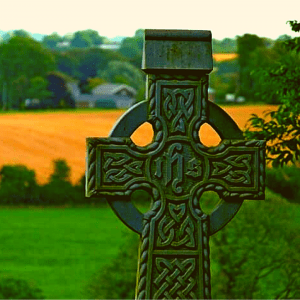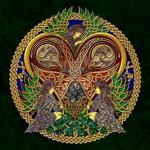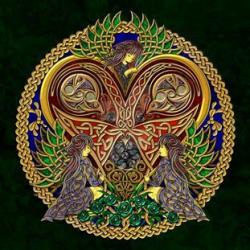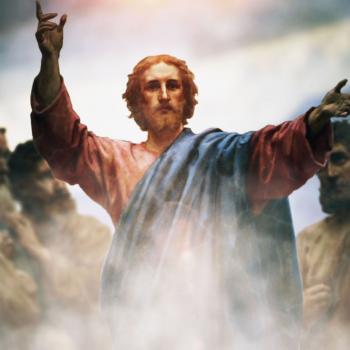
Like many I was shocked at the January 6 riot at the capitol. But a picture caught my eye in particular that contained a hallmark associated with Celtic Spirituality. On a white cloth, being carried as a QAnon flag was a Celtic Cross. This sight took me by surprise and shocked me into the reality that a symbol of my faith was being hijacked. This is a major concern, since I am finding more and more that there is little understanding and even aversion to the concept of Celtic Spirituality. Many Christian movements see the tradition as naturism, the worship of nature or as a discarded part of Catholic faith. These misconceptions have led to misinformation about the practice of Celtic Spirituality causing some to label it heresy.
With this bombardment of misinformation, it does the Celtic faith significant damage to also now have one of its most iconic and well-known symbols being used by a group as far away from Celtic Spirituality as QAnon or other groups that were present. This is not written to attack the beliefs of QAnon or other groups. This post is to set the record straight about the Celtic Cross, its origins, its uses and its history. The truth is, the history of the Celtic cross is not in line with any known QAnon beliefs or stated goals. This is not an attack piece; this is an education piece.
The Celtic Crosses Beginning
To understand the beginnings of the Celtic cross, it is important to understand the history of Pre-Christian Ireland. In ancient Ireland, fencing, walls and hedging all declared that the ground within was set apart. The land was different than the area around it. In ancient Christian Ireland, circles of stone crosses stood as a hedge. This declared that the ground within was also different: it belonged to God. In the modern world, we see crosses riddled throughout cemeteries. Those crosses are marking a moment of burial and death. The Celts used them to mark moments
Early Celtic Christians marked their lives by moments with crosses. They were saying that whatever happened in this moment was different and it belonged to God. In this way, they had borrowed from their earlier culture of marking things when they needed to be set apart. But the Celts not only did this with churches, they did this with the moments in their life. Pre Christian Celts would use stone pillars and affixed circles to the top, honoring the greatest natural deity, the sun. Later, the Christian Celts simply added pieces to the sides of the old pillars used to honor the sun, making a cross with a circle in the middle. Thus, the Celtic Cross was born. Honoring the God that was greater than the sun.
The Celtic Cross as a Missionary Tool
The first Christians in Ireland were converted from the local religion, which was druidism. Similarly to the way Roman Christians adopted their church buildings from their former faith, so did the Irish bring how they had marked holy places and times from their culture. In the druid fashion, these markers would be stone or wood and almost always had a circle on them, symbolizing the sun as a major god to the Celts.
The first Christian missionaries understood in order to spread the gospel in Ireland, connections must be made from culture to faith. The early missionaries made it clear that the sun was still particularly important, but that there was an even more powerful force behind the workings of the sun, the Most High God. The missionaries then took these pillars with a circle at the top and fashioned the cross around the circle, and hence we have the basic Celtic cross we see today.
Change of Faith Does Not Equal Change of Culture
When the Christian missionaries began their work, they did not attempt to change the culture of the Irish as well as their religion. The idea of the destruction and removal of culture in order to Christianize a population would have been horrifying to the first missionaries to Ireland. This is the first difference between how the cross was represented on capitol hill and its true origin. The Celtic Cross was not a tool to force people out of their culture, but a way to meld their God given culture with the saving power of the gospel of Jesus Christ. The Cross teaches us that God made different cultures and does not desire to see them whitewashed into conformity but celebrated in in the Christian family.
This inclusive Celtic cross reminds us that Christianity is not a social club requiring conformity, but an open and inviting place for all people and cultures. Many times, sights that were once culturally druid were adopted as Christian holy sites and the symbol was reworked into a Celtic Cross, yet the culture remained and flourished. This directly contributed to the success Christian missionaries had in Ireland while African and Native American missionaries were not successful and in many cases harmful and destructive to the cultures they were evangelizing. Where the latter sought to erase culture, the former sought to incorporate culture. This is a timely lesson for today.
The Cross for Places, Teaching, and Prayer
The Celtic Cross was often used to mark a place where a significant event had occurred. These could be anything from a battle won, a miracle, healing or even a holy place, person or event. Many priests in Ireland were travelers that went from place to place and their meetings were often marked by these crosses. As these crosses and the faith represented by them spread into the culture rather than destroying it, towns were often named because of the presence of these Celtic markers. Places like Waltham Cross and Crosswaite were so named. These were early historical markers for the Celts to look on and remember a piece of their Christian history.
The Celtic Crosses were also many times highly decorated to assist with biblical teaching to a community that did not have a high literacy rate. These visual aids were used to describe Adam and Eve, the life of Jesus and His crucifixion or other biblical stories. These were the ancient Celtic version of Netflix for Christians to view and understand difficult biblical concepts without the ability to read.
Lastly, but, most importantly these Celtic crosses were used for prayer. These markers were meant to be a sort of “drive up” chapel where travelers could sit and pray and draw on the mysteries of God and Christ. These were places the traveler could pause and come close in prayer to the majesty of the God who was greater than even the sun that they had previously worshipped. John 4 tells us that Jesus declared a time was coming when we would worship the father not in Jerusalem or in a temple, but in spirit and truth. And since the Holy Spirit is carried in the heart of the believer, where the believer stops to pray is Holy Ground! This meant to the Celts that wherever these crosses were found, there was a holy place by which a person could rest and draw nearer to God in spirit and in truth.
The Celtic Cross is a Symbol of Unity in Cultural Diversity
Those who carried this beautiful symbol of cultural unity in Christ to Capitol hill in January clearly did not understand the history behind this symbol of Celtic Christianity. The more important question is “Do we understand?” Do we understand that culture is not to be crushed but celebrated? Do we understand that dominance is not a trait of Christian practice? If we do not accept those things, we should not use the Celtic symbol that embodies them.












